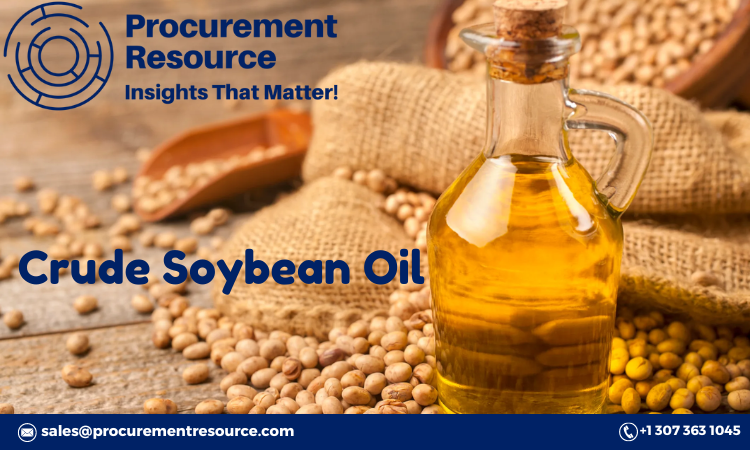1. Introduction to Crude Soybean Oil Price Market Analysis
In the dynamic world of commodities, Crude Soybean Oil has become a pivotal component within the edible oil sector. Market fluctuations, global demand, and climatic conditions all contribute to the varying price trends seen in the Crude Soybean Oil market. Through a robust Crude Soybean Oil Price Market Analysis, stakeholders can better understand these fluctuations, forecast trends, and make well-informed decisions. This analysis explores the primary factors influencing price shifts, including production, trade policies, and demand from both food and industrial sectors.
Request For Free Sample: https://www.procurementresource.com/resource-center/crude-soybean-oil-price-trends/pricerequest
2. In-Depth Crude Soybean Oil Price Analysis
The Crude Soybean Oil Price analysis investigates the multifaceted influences on pricing within the soybean oil market. As of 2024, several key factors have emerged:
- Supply Chain and Production Costs: Production costs, influenced by factors such as seed availability, labor expenses, and climatic conditions, directly affect the crude soybean oil price.
- Global Demand and Consumption Patterns: The demand for soybean oil in both culinary and industrial applications continues to expand, particularly in markets like China and India, which play a significant role in driving up the prices.
- Government Policies and Trade Tariffs: Import-export tariffs and subsidies on soybean oil can lead to either price stabilization or volatility, depending on the current economic landscape.
Analyzing these factors provides a clear view of how market shifts occur, enabling stakeholders to anticipate future price changes and develop sound business strategies.
3. Visualizing Trends with the Crude Soybean Oil Price Chart
A Crude Soybean Oil Price Chart is essential for visually interpreting price changes over specific periods. The chart typically displays monthly, quarterly, or yearly price fluctuations, helping traders, analysts, and investors track the trajectory of soybean oil prices. Key trends can often be spotted, such as:
- Seasonal Trends: Prices often peak during high-demand seasons, like holiday periods, where soybean oil is widely used in food preparation.
- Market Reactions to Climatic Events: Poor weather conditions impacting soybean crop yields in major producing countries like the U.S. and Brazil can lead to a spike in crude soybean oil prices. Charts help to pinpoint these periods of volatility.
- Supply Chain Disruptions: Global events, such as pandemics or trade disputes, can disrupt supply chains, reflecting sudden shifts in pricing that can be tracked using the price chart.
Understanding these patterns enables industry players to make more data-driven decisions.
4. Examining the Crude Soybean Oil Price Trend
The Crude Soybean Oil Price Trend illustrates the overarching direction of pricing over time, whether it is increasing, decreasing, or remaining stable. Some current trends in 2024 include:
- Growing Demand for Biofuels: With increased interest in sustainable energy, crude soybean oil has seen a rise in demand within the biofuel industry, leading to upward price trends.
- Export Growth from Major Producers: Countries like the U.S., Brazil, and Argentina are experiencing a surge in soybean oil exports, supported by favorable trade policies, further pushing the trend in an upward trajectory.
- Technology-Driven Production Efficiency: Advanced agricultural techniques and innovations in oil extraction are improving efficiency, which could contribute to more stable or declining price trends over the long term.
Analyzing these trends is crucial for companies aiming to capitalize on long-term price movements and develop effective pricing strategies.
5. Interpreting the Crude Soybean Oil Price Index
The Crude Soybean Oil Price Index is a valuable tool that reflects price movements relative to a specific base period. It is frequently used to compare prices over different time periods, offering insights into the overall health of the market and long-term price shifts. Key considerations include:
- Base Year Comparison: By setting a base year, the price index helps identify inflation-adjusted growth rates and reveals whether the crude soybean oil price is rising faster than general inflation.
- Market Volatility Indicators: An index with sharp increases or decreases can indicate periods of significant market instability, often linked to global events or shifts in supply and demand dynamics.
- Sector-Specific Index Tracking: Some indices specifically track soybean oil for use in certain industries, like biodiesel or the food industry, offering more granular insights for industry-specific analysis.
6. Visual Representation with the Crude Soybean Oil Price Graph
The Crude Soybean Oil Price Graph serves as a visual summary, offering an immediate understanding of historical and current pricing patterns. A comprehensive graph typically includes multiple data points, enabling viewers to:
- Identify Highs and Lows: Historical data points indicate peaks and troughs in pricing, often correlating with key events in global markets.
- Assess Long-Term Trends: Viewing the price over a 5-year or 10-year timeline can help in assessing whether the market is experiencing sustained growth or volatility.
- Support Forecasting Efforts: For investors and industry stakeholders, graphs provide a baseline to compare against future projections, aiding in the development of realistic pricing forecasts.
About Us:
Procurement Resource is an invaluable partner for businesses seeking comprehensive market research and strategic insights across a spectrum of industries. With a repository of over 500 chemicals, commodities, and utilities, updated regularly, they offer a cost-effective solution for diverse procurement needs. Their team of seasoned analysts conducts thorough research, delivering clients with up-to-date market reports, cost models, price analysis, and category insights.
By tracking prices and production costs across various goods and commodities, Procurement Resource ensures clients receive the latest and most reliable data. Collaborating with procurement teams across industries, they provide real-time facts and pioneering practices to streamline procurement processes and enable informed decision-making. Procurement Resource empowers clients to navigate complex supply chains, understand industry trends, and develop strategies for sustainable growth.
Contact Us:
Company Name: Procurement Resource
Contact Person: Benking sley
Email: sales@procurementresource.com
Toll Free Number: USA & Canada – Phone no: +1 307 363 1045 | UK – Phone no: +44 7537 132103 | Asia-Pacific (APAC) – Phone no: +91 1203185500
Address: 30 North Gould Street, Sheridan, WY 82801, USA

